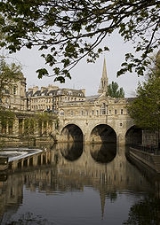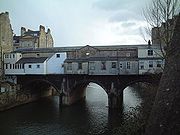
Pulteney Bridge
Encyclopedia
Pulteney Bridge is a bridge
that crosses the River Avon
, in Bath, England
. It was completed in 1773 and is designated by English Heritage
as a grade I listed building.
The bridge was designed by Robert Adam
, whose working drawings are preserved in the Sir John Soane's Museum, and is one of only four bridges in the world with shops across the full span on both sides. Shops on the bridge include a flower shop, antique map shop, and juice bar.
It is named after Frances Pulteney, heiress in 1767 of the Bathwick
estate across the river from Bath. Bathwick was a simple village in a rural setting, but Frances's husband William could see its potential. He made plans to create a new town, which would become a suburb to the historic city of Bath. First he needed a better river crossing than the existing ferry, hence the bridge.
Pulteney approached the brothers Robert and James Adam with his new town in mind, but Robert Adam then became involved in the design of the bridge. In his hands the simple construction envisaged by Pulteney became an elegant structure lined with shops. Adam had visited both Florence
and Venice
, where he would have seen the Ponte Vecchio
and the Ponte di Rialto. But Adam's design more closely followed Andrea Palladio
's rejected design for the Rialto.
 Pulteney Bridge stood for less than 20 years in the form that Adam created. In 1792 alterations to enlarge the shops marred the elegance of the façades. Floods in 1799 and 1800 wrecked the north side of the bridge, which had been constructed with inadequate support. It was rebuilt by John Pinch senior, surveyor to the Pulteney estate, in a less ambitious version of Adam's design. 19th-century shopkeepers altered windows, or cantilevered out over the river as the fancy took them. The western end pavilion on the south side was demolished in 1903 for road widening and its replacement was not an exact match.
Pulteney Bridge stood for less than 20 years in the form that Adam created. In 1792 alterations to enlarge the shops marred the elegance of the façades. Floods in 1799 and 1800 wrecked the north side of the bridge, which had been constructed with inadequate support. It was rebuilt by John Pinch senior, surveyor to the Pulteney estate, in a less ambitious version of Adam's design. 19th-century shopkeepers altered windows, or cantilevered out over the river as the fancy took them. The western end pavilion on the south side was demolished in 1903 for road widening and its replacement was not an exact match.
In 1936 the bridge became scheduled as a national monument, with plans being made for the restoration of the original façade. The restoration was completed in time for the Festival of Britain
in 1951, with further work being carried out in 1975. It is now one of the best-known buildings in a city famed for its Georgian architecture
.
In 2009 Bath and North East Somerset
council put forward plans to ban vehicles from the bridge and turn it into a pedestrianised zone.
Bridge
A bridge is a structure built to span physical obstacles such as a body of water, valley, or road, for the purpose of providing passage over the obstacle...
that crosses the River Avon
River Avon, Bristol
The River Avon is an English river in the south west of the country. To distinguish it from a number of other River Avons in Britain, this river is often also known as the Lower Avon or Bristol Avon...
, in Bath, England
England
England is a country that is part of the United Kingdom. It shares land borders with Scotland to the north and Wales to the west; the Irish Sea is to the north west, the Celtic Sea to the south west, with the North Sea to the east and the English Channel to the south separating it from continental...
. It was completed in 1773 and is designated by English Heritage
English Heritage
English Heritage . is an executive non-departmental public body of the British Government sponsored by the Department for Culture, Media and Sport...
as a grade I listed building.
The bridge was designed by Robert Adam
Robert Adam
Robert Adam was a Scottish neoclassical architect, interior designer and furniture designer. He was the son of William Adam , Scotland's foremost architect of the time, and trained under him...
, whose working drawings are preserved in the Sir John Soane's Museum, and is one of only four bridges in the world with shops across the full span on both sides. Shops on the bridge include a flower shop, antique map shop, and juice bar.
It is named after Frances Pulteney, heiress in 1767 of the Bathwick
Bathwick
Bathwick is an electoral ward in the City of Bath, England, on the opposite bank of the River Avon to the historic city centre.Bathwick was part of the hundred of Bath Forum....
estate across the river from Bath. Bathwick was a simple village in a rural setting, but Frances's husband William could see its potential. He made plans to create a new town, which would become a suburb to the historic city of Bath. First he needed a better river crossing than the existing ferry, hence the bridge.
Pulteney approached the brothers Robert and James Adam with his new town in mind, but Robert Adam then became involved in the design of the bridge. In his hands the simple construction envisaged by Pulteney became an elegant structure lined with shops. Adam had visited both Florence
Florence
Florence is the capital city of the Italian region of Tuscany and of the province of Florence. It is the most populous city in Tuscany, with approximately 370,000 inhabitants, expanding to over 1.5 million in the metropolitan area....
and Venice
Venice
Venice is a city in northern Italy which is renowned for the beauty of its setting, its architecture and its artworks. It is the capital of the Veneto region...
, where he would have seen the Ponte Vecchio
Ponte Vecchio
The Ponte Vecchio is a Medieval stone closed-spandrel segmental arch bridge over the Arno River, in Florence, Italy, noted for still having shops built along it, as was once common. Butchers initially occupied the shops; the present tenants are jewellers, art dealers and souvenir sellers...
and the Ponte di Rialto. But Adam's design more closely followed Andrea Palladio
Andrea Palladio
Andrea Palladio was an architect active in the Republic of Venice. Palladio, influenced by Roman and Greek architecture, primarily by Vitruvius, is widely considered the most influential individual in the history of Western architecture...
's rejected design for the Rialto.

In 1936 the bridge became scheduled as a national monument, with plans being made for the restoration of the original façade. The restoration was completed in time for the Festival of Britain
Festival of Britain
The Festival of Britain was a national exhibition in Britain in the summer of 1951. It was organised by the government to give Britons a feeling of recovery in the aftermath of war and to promote good quality design in the rebuilding of British towns and cities. The Festival's centrepiece was in...
in 1951, with further work being carried out in 1975. It is now one of the best-known buildings in a city famed for its Georgian architecture
Georgian architecture
Georgian architecture is the name given in most English-speaking countries to the set of architectural styles current between 1720 and 1840. It is eponymous for the first four British monarchs of the House of Hanover—George I of Great Britain, George II of Great Britain, George III of the United...
.
In 2009 Bath and North East Somerset
Bath and North East Somerset
Bath and North East Somerset is a unitary authority that was created on 1 April 1996 following the abolition of the County of Avon. It is part of the Ceremonial county of Somerset...
council put forward plans to ban vehicles from the bridge and turn it into a pedestrianised zone.

